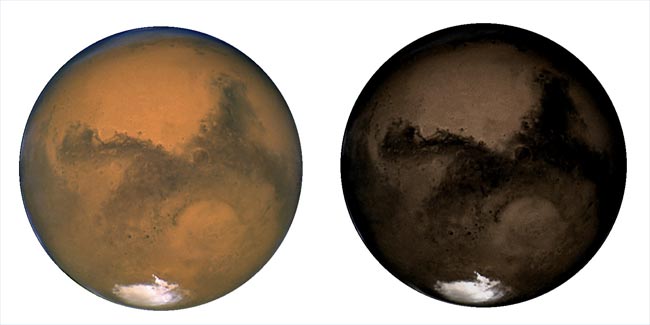A new hypothesis suggests that Mars is not always red and explains why the planet is so red.
Until recently, scientists still thought that the red on Mars was the product of a water flowing on Mars's surface billions of years ago and rusting the color of the stone. However, after landing on this planet in 2004, the Mars discovery ship Spirit and Opportunity found evidence of some minerals that could be destroyed by water, which means red dust on the star. The fire had no relation to the water flowing on it.
'This is surprising,' says Jonathan Merrison , a scientist at Mars Simulation Lab Aarhus in Denmark.
Currently there is a new study that has devised a feasible way to explain the reddish color of Mars, which has nothing to do with water. The study deduced that the fact that red characteristics are only in recent times, the gradual wear and tear of the rocks creates a red mineral and covers the color of Mars.
Laboratory test
To test the reasoning, Merison and her colleagues put quartz sand in a sealed glass jar, and then use the machine to rotate them many times. This degree of rotation is approximately the level of light blowing on Mars's surface, enough to produce corrosion and as a result 10% of that sand has turned into dust crystals within seven months.
 The picture to the right may be the image of Mars for a while - there is no reddish color like the picture on the left. This is a new hypothesis, which uses wind corrosion instead of water to prove the red formation on Mars. (Photo: NASA / ESA / Hubble Team.)
The picture to the right may be the image of Mars for a while - there is no reddish color like the picture on the left. This is a new hypothesis, which uses wind corrosion instead of water to prove the red formation on Mars. (Photo: NASA / ESA / Hubble Team.)
The scientists then added it to a ferromagnetic flask, an iron oxide present on Mars.
They continued to rotate the sandbag and observed that the sand color was getting more and more red.
Merrison shared with SPACE.com: 'At the end of the experiment, we found red on the glass jar. We think that this process can explain the red on Mars, it has nothing to do with water like the previous hypothesis. '
When sand grains are rotated in the bottle, they collide with each other, break and separate from the chemical bond at the impacted surfaces. These impacted surfaces when contacted with ferromagnetic powder will cause an oxygen atom to be transferred to that magnetic substance and to form a new iron oxide with a red hematite. According to Merrison, only a little hematite can redeem Mars.
The same fact on Mars?
Although scientists have not yet proven what actually happened on Mars, the explanation of not needing water during the red formation on Mars seems quite reasonable.

An American self-propelled probe on Mars.(Photo: NASA)
In fact, due to the relatively fast process, the thin red layer on Mars may be a new object for research.
Merrison scientist said: 'I think we can deduce from that that Mars is not always red. Previously, researchers in this field thought the surface of Mars was billions of years old and always red. However, our research shows that the red is only millions of years ago, not billions of years. "
He reported the results of his research to the European Planetary Congress in Germany last week.
 Van Allen's belt and evidence that the Apollo 11 mission to the Moon was myth
Van Allen's belt and evidence that the Apollo 11 mission to the Moon was myth The levels of civilization in the universe (Kardashev scale)
The levels of civilization in the universe (Kardashev scale) Today Mars, the sun and the Earth are aligned
Today Mars, the sun and the Earth are aligned The Amazon owner announced a secret plan to build a space base for thousands of people
The Amazon owner announced a secret plan to build a space base for thousands of people